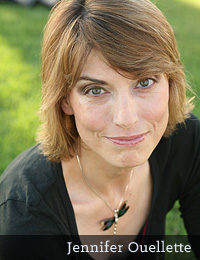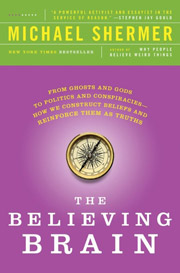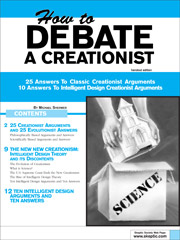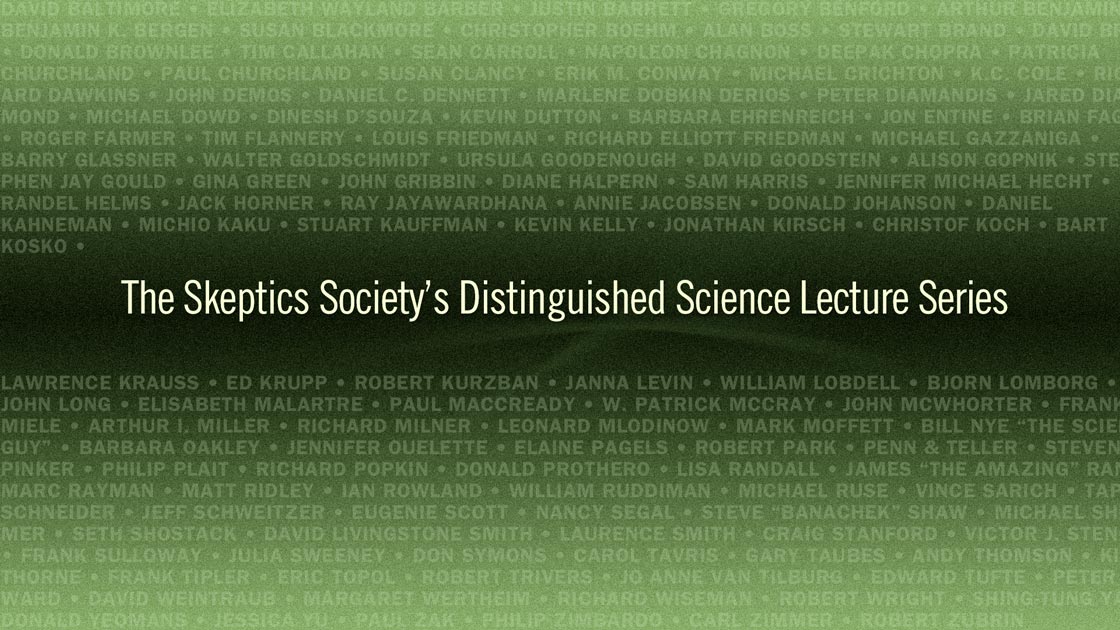In this week’s eSkeptic:
Lecture This Sunday at Caltech

Me, Myself and Why: Searching for the
Science of Self
with Jennifer Ouelette
Sun., Jan. 26, 2014 at 2 pm
POPULAR SCIENCE WRITER Jennifer Ouellette has tackled math in The Calculus Diaries and physics in both The Physics of the Buffyverse and Black Bodies and Quantum Cats. In Me, Myself and Why she turns her attention to the science of the self and delivers a fascinating survey of the forces that shape who we are and why we act the way we do. Ouellette acts as both journalist and subject, as she takes a battery of personality tests, has her genes sequenced and an MRI brain scan done, and even goes on her first and only LSD trip, all the while taking the reader along for the ride. As an adoptee, with basic information about her biological parents, Ouellette considers what traits she undeniably has inherited through genetics and what traits she has in common with her siblings (also adoptees) and her parents, which leads to a fascinating discussion on synapses and how the brain is wired and continues to change as we grow older.
Order Me, Myself and Why from Amazon.


Test For Intelligence?
SKEPTICALITY EPISODE 224
This week on Skepticality, Derek interviews Keith E. Stanovich, a CSI fellow, and the Canada Research Chair of Applied Cognitive Science at the Department of Human Development and Applied Psychology, University of Toronto. His work in critical thinking and how science goes about measuring intelligence has won him many awards. Derek wanted to find out a bit more about his work and what areas of research he has been working on in recent days.
About this week’s eSkeptic
Ideas change, and the times we live in change. Perhaps the biggest change today is the rate of change. What established scientific idea is ready to be moved aside so that science can advance? In this week’s eSkeptic, we present Michael Shermer’s answer to the Edge.org Annual Question for 2014: “What Scientific Idea is Ready for Retirement?” Shermer was one of 174 contributors this year.
Michael Shermer is the Publisher of Skeptic magazine, a monthly columnist for Scientific American, and author of 12 books, including The Believing Brain: From Ghosts, Gods, and Aliens to Conspiracies, Economics, and Politics—How the Brain Constructs Beliefs and Reinforces Them as Truths.
Share this article with friends online.
Subscribe | Donate | Watch Lectures | Shop

Hard-Wired = Permanent
by Michael Shermer
We should retire the scientific idea that a hard-wired trait or characteristic of an organism is a permanent feature. Case in point: God and religion.
Ever since Charles Darwin theorized in his 1871 book The Descent of Man that “a belief in all-pervading spiritual agencies seems to be universal” and therefore an evolved characteristic of our species that is hardwired into our brains, scientists have been running experiments and conducting surveys to show why God won’t go away. Anthropologists have found such human universals as specific supernatural beliefs about death and the afterlife, fortune and misfortune, and especially magic, myths, rituals, divination and folklore. Behavior geneticists report from twin studies—most notably twins separated at birth and raised in different environments—that 40–50% of the variance of God beliefs and religiosity are genetic. Some scientists have even claimed to have found a “God gene” (or more precisely, a “God gene complex”) that leads humans to have a need for spiritual transcendence and belief in a higher power of some kind. Even specific elements of religious stories—such as a destructive flood, a virgin birth, miracles, a resurrection from the dead—seem to appear independently of one another over and over again throughout history in a wide variety of cultures, implying that there is a hard-wired component to religion and God beliefs. I have held this theory myself. Until now.

The Believing Brain
$15.99
Dr. Michael Shermer presents his comprehensive theory on how beliefs are born, formed, nourished, reinforced, challenged, changed, and extinguished. We form our beliefs for a variety of subjective, personal, emotional, and psychological reasons in the context of environments created by family, friends, colleagues, culture, and society at large; after forming our beliefs we then defend, justify, and rationalize them with a host of intellectual reasons, cogent arguments, and rational explanations. Beliefs come first, explanations follow.
ORDER the hardback
ORDER the paperback
ORDER the lecture on DVD
ORDER the unabridged CD
If and when we establish a permanent colony on Mars, if its members consist of nonbelieving scientists with a purely secular worldview it would be interesting to check in 10 (or 100) generations to see if God has returned. Until that experiment is conducted, however, we have to consider the results of natural experiments run here on Earth. In the Western world, for example, a 2013 survey of 14,000 people in 13 nations (Germany, France, Sweden, Spain, Switzerland, Turkey, Israel, Canada, Brazil, India, South Korean, and the UK and US) conducted by the German pollster Bertelsmann Stiftung for their Religion Monitor found that most of these countries showed a declining trend in religiosity and belief in God, especially among the youth. In Spain, for example, 85% of respondents over the age of 45 report being moderately to very religious, but only 58% of those under 29 years of age so report. In Europe in general, only 30–50% said that religion is important in their own lives, and in many European countries less than a third say that they believe in God.
Even in the über religious United States, the pollsters found that 31% of Americans say they are “not religious or not very religious.” This finding confirms those of a 2012 Pew Forum survey that found that the fastest growing religious cohort in America are the “Nones” (those with no religious affiliation) at 20% (33% of adults under 30), broken down into atheists and agnostics at 6% and the unaffiliated at 14%. The raw numbers are stunning: with the U.S. adult population (age 18 and over) at 240 million, this translates into 48 million Nones, or 14.4 million atheists/agnostics and 33.6 million unaffiliated. There were also generational differences that reveal a significant trend toward unbelief, with the “Greatest” generation (born 1913–1927) at 5%, the “Silent” generation (born 1928–1945) at 9%, the “Boomers” (born 1946–1964) at 15%, the “GenXers” (born 1965–1980) at 21%, the “Older Millennials” (born 1981–1989) at 30%, and the “Younger Millennials” (born 1990–1994) at 34%.
At this rate I project that the Nones will reach 100% in the year 2220.
It is time for scientists to retire the theory that God and religion are hardwired in our brains. Like everyone else, scientists are subject to cognitive biases that tilt their thinking toward trying to explain common beliefs, so it is good for us to take the long-view perspective and compare today to, say, half a millennia ago when God beliefs were virtually 100%, or to the hunter-gatherer tribes of our Paleolithic ancestors who, while employing any number of superstitious rituals, did not believe in a God or practice a religion that even remotely resembles the deities or religions of modern peoples.

How to Debate
a Creationist
$5.00 (discounts on 5+)
This 28-page booklet is perfect for anyone who wants to know how to converse with a creationist. It contains 25 creationist arguments and 25 evolutionist answers (some philosophical and some scientific); describes what the theory of evolution is and isn’t and explains why creationism is not science; provides an in-depth understanding of Intelligent Design, its pitfalls, logical fallacies, and more.
ORDER the booklet
This indicates that religious faith and belief in God is a byproduct of other cognitive processes (e.g., agency detection) and cultural propensities (the need to affiliate) that, while hard-wired, can be expunged through reason and science in the same manner as any number of other superstitious rituals and supernatural beliefs once held by the most learned scholars and scientists of Europe five centuries ago. For example, at that time the prevailing theory to explain crop failures, weather anomalies, diseases, and various other maladies and misfortunes was witchcraft, and the solution was to strap women to pyres and torch them to death. Today, no one in their right mind believes this. With the advent of a scientific understanding of agriculture, climate, disease, and other causal vectors—including the role of chance—the witch theory of causality fell into disuse.
So it has been and will continue to be with other forms of the hard-wired = permanent idea, such as violence. We may be hard-wired for violence, but we can attenuate it considerably through scientifically tested methods. Thus, for my test case here, I predict that in another 500 years the God-theory of causality will have fallen into disuse, and the 21st-century scientific theory that God is hardwired into our brains as a permanent feature of our species will be retired. ![]()
Lisa Randall, On Demand
Warped Passages: Unraveling the Mysteries of the Universe’s Hidden Dimensions
The concept of additional spatial dimensions is as far from intuitive as any idea can be. In this lecture, based on her book, Dr. Randall employs creative analogies to explain how our universe may have many unseen dimensions. Randall works hard to make her astoundingly complex material understandable, providing a great deal of background for recent advances in string and supersymmetry theory. As coauthor of the two most important scientific papers on this topic, she’s ideally suited to explain these ideas. Although physicists do not yet know if there are extra dimensions a fraction of a millimeter in size, dimensions of infinite size, or only the dimensions we see, Randall shows how these theories will be tested in coming years.
Rent this video for only $3.95
or explore the entire series.
INSTRUCTIONS: Click the button above, then click the RENT ONE button on the page that will open in your Internet browser. You will then be asked to login to your Vimeo account (or create a free account). Once you complete your purchase of the video rental, you will then be able to instantly stream the video to your computer, smartphone, or tablet, and watch it for the rental period.













